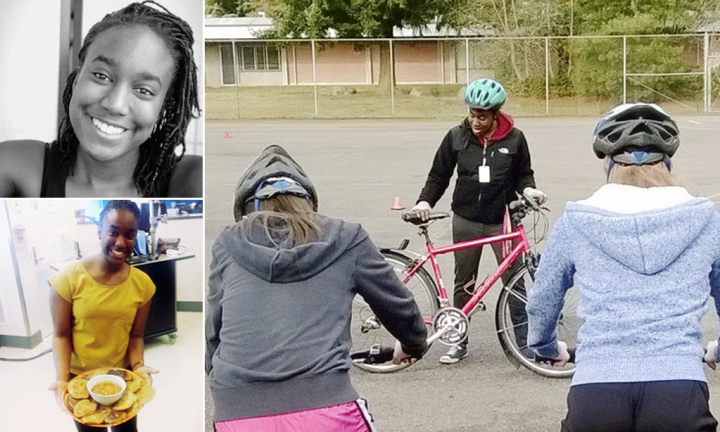Khatsini is a Seattleite passionate about youth empowerment, healthy foods and futures, economic mobility, financial literacy, biking, dancing, photography and making things. She’s studied the arts, 3-D modeling, and hand drafting in college, and is currently pursuing a business degree at the University of Washington. Khatsini is most excited about the intersections of imagination, innovation, and resourcefulness. These were ever-present tools in her past work as a bicycle and pedestrian safety instructor, a youth facilitator and in the kitchen when cooking for fun or with friends.
Khatsini serves on the board of FEEST Seattle, a non-profit school-based program that empowers youth of color and immigrant youth through cooking, leadership development and food systems change and advocacy. She’s always looked forward to the Seattle Design Festival every year and is excited to contribute in 2016 with her first interactive design project!
Q: Design Change is…
A: An opportunity to disrupt the way things are and build something new.
Q: What’s the big opportunity for design in Seattle?
A: The theme “Design Change” is especially relevant given the rapid growth and development Seattle is experiencing. Today the city’s residents and leadership face the challenge of facilitating the Seattle’s growth and subsequent changes in an equitable way.
Q: Seattle will be…
A: What we make it.
Q: When did you first understand the concept of “design” – that “design” exists?
A: I love to build things, take them apart and think about how systems work. While I’m not a designer by profession, I often think about patterns of thought, matter and motion, especially as they relate to people and public spaces. I began thinking about how streets and cities were designed as a kid, venturing out around the city on my bike.
While growing up in a mixed-income housing development I was constantly aware that I was living inside of someone’s else design, a design that affected how and where I moved, as well as my proximity to resources- transportation, parks, schools, healthy food, recreation, and other amenities.
This experience and many others have invoked the following questions: how do public spaces enable, restrict, encourage, or prevent certain behaviors? How does design affect one’s privacy, dignity, economic mobility, and life expectancy? To what extent should urban design cultivate these things? I am especially interested in the intersection of design and transportation, access to healthy food and recreation. These interests have led me to pursue architectural graphics, teach safe cycling and pedestrian safety with the Cascade Bicycle Club and Alta Planning & Design, and participate (and now sit on the board of) FEEST Seattle, a school-based program that empowers youth of color and immigrant youth through cooking, food systems change, and leadership development.
I believe everyone can be design agents in their own lives. Whether you are designing your day, or your life, or your character – you can incite change. When thinking about the theme “design change” as it relates to Seattle I ask myself:who is designing for whom? What does it feel like to be an active and empowered citizen? I thought this project might be a step in that direction for me.
Q: Is there anything else you’d like to share with our readers?
A: I believe that from a young age, children should be empowered to think about design in their lives. I remember as a youth, drawing a lot of support from adults who believed in my potential and finding outlets to incite change through writing and biking. It’s too easy to feel disempowered as a young person, especially when there aren’t many avenues for meaningful contribution to systemic changes in our city. These processes should be both exciting and challenging, but most of all inclusive.
Learn more about Khatsini:
FEEST Seattle
Email – khatsini.simani@gmail.com
Twitter – @simanisimani





